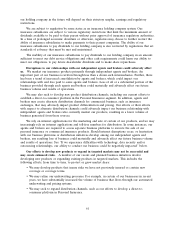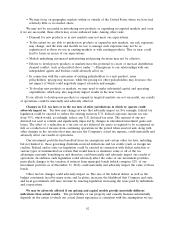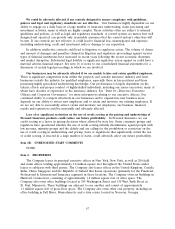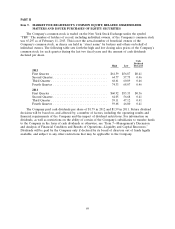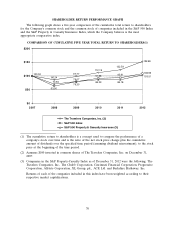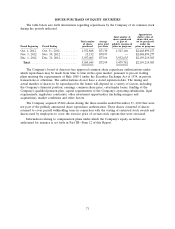Travelers 2012 Annual Report Download - page 74
Download and view the complete annual report
Please find page 74 of the 2012 Travelers annual report below. You can navigate through the pages in the report by either clicking on the pages listed below, or by using the keyword search tool below to find specific information within the annual report.• We may focus on geographic markets within or outside of the United States where we have had
relatively little or no market share.
We may not be successful in introducing new products or expanding in targeted markets and, even
if we are successful, these efforts may create enhanced risks. Among other risks:
• Demand for new products or in new markets may not meet our expectations.
• To the extent we are able to market new products or expand in new markets, our risk exposures
may change, and the data and models we use to manage such exposures may not be as
sophisticated as those we use in existing markets or with existing products. This, in turn, could
lead to losses in excess of our expectations.
• Models underlying automated underwriting and pricing decisions may not be effective.
• Efforts to develop new products or markets have the potential to create or increase distribution
channel conflict, such as described above under ‘‘—Disruptions to our relationships with our
independent agents and brokers could adversely affect us.’’
• In connection with the conversion of existing policyholders to a new product, some
policyholders’ pricing may increase, while the pricing for other policyholders may decrease, the
net impact of which could negatively impact retention and margins.
• To develop new products or markets, we may need to make substantial capital and operating
expenditures, which may also negatively impact results in the near term.
If our efforts to develop new products or expand in targeted markets are not successful, our results
of operations could be materially and adversely affected.
Changes in U.S. tax laws or in the tax laws of other jurisdictions in which we operate could
adversely impact us. Tax laws may change in ways that adversely impact us. For example, federal tax
legislation could be enacted to reduce the existing statutory U.S. federal corporate income tax rate
from 35%, which would, accordingly, reduce any U.S. deferred tax asset. The amount of any net
deferred tax asset is volatile and significantly impacted by changes in unrealized investment gains and
losses. The effect of a reduction in a tax rate on net deferred tax assets is required to be recognized, in
full, as a reduction of income from continuing operations in the period when enacted and, along with
other changes in the tax rules that may increase the Company’s actual tax expense, could materially and
adversely affect our results of operations.
Our investment portfolio has benefited from tax exemptions and certain other tax laws, including,
but not limited to, those governing dividends-received deductions and tax credits (such as foreign tax
credits). Federal and/or state tax legislation could be enacted in connection with deficit reduction or
various types of fundamental tax reform that would lessen or eliminate some or all of the tax
advantages currently benefiting us and therefore could materially and adversely impact our results of
operations. In addition, such legislation could adversely affect the value of our investment portfolio,
particularly changes to the taxation of interest from municipal bonds (which comprise 52% of our
investment portfolio as of December 31, 2012) could materially and adversely impact the value of those
bonds.
Other tax law changes could adversely impact us. The size of the federal deficit, as well as the
budget constraints faced by many states and localities, increases the likelihood that Congress and state
and local governments will raise revenue by enacting legislation increasing the taxes paid by individuals
and corporations.
We may be adversely affected if our pricing and capital models provide materially different
indications than actual results. The profitability of our property and casualty business substantially
depends on the extent to which our actual claims experience is consistent with the assumptions we use
62











